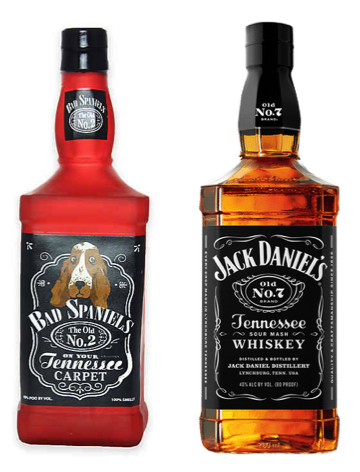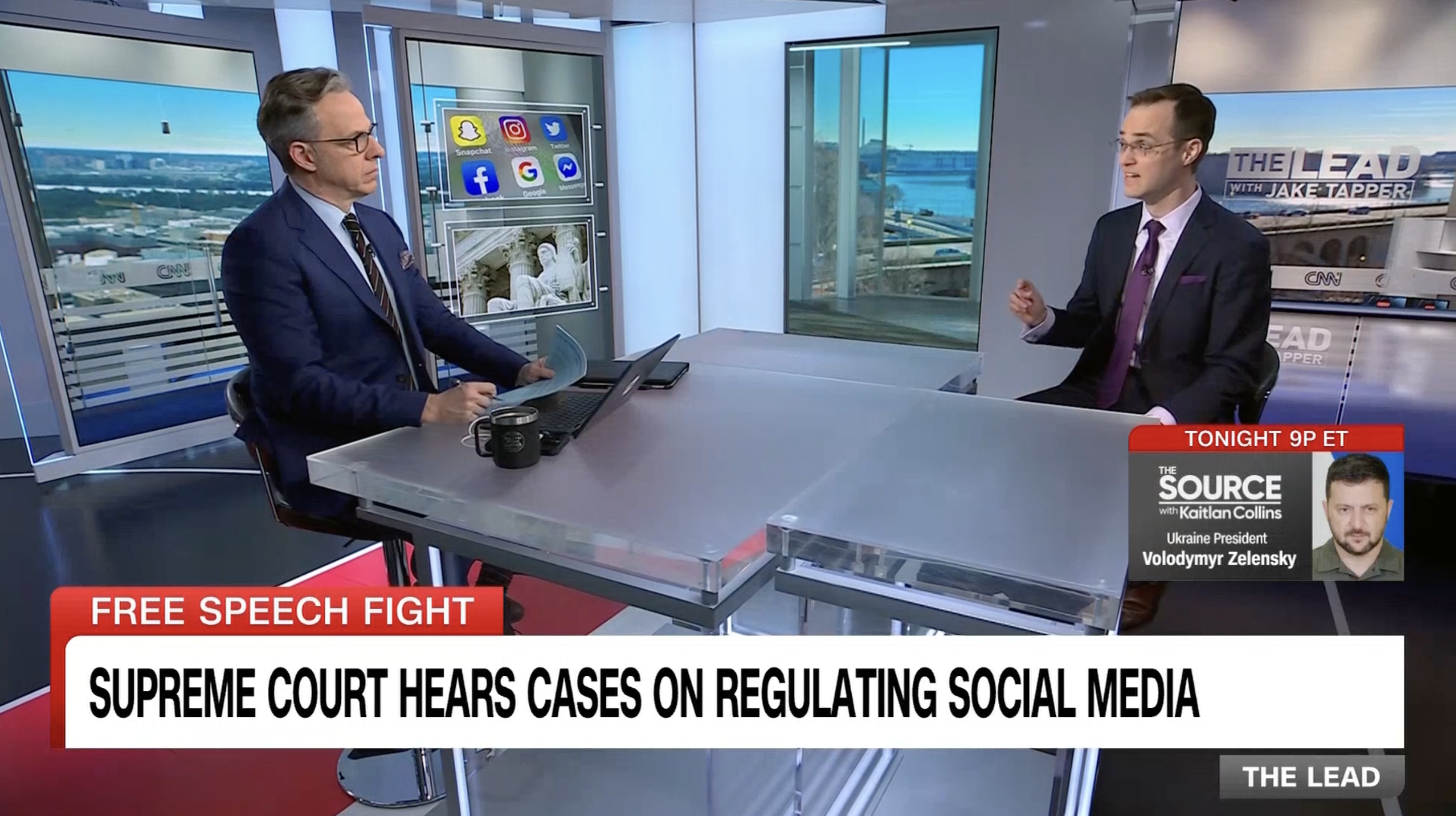“Bad Spaniels”: The Dog Toy Questioning Balance between First Amendment and Trademark Protections

On March 22, 2023, the Supreme Court heard oral argument from the Office of the Solicitor General and the parties in Jack Daniel’s Properties, Inc. v. VIP Products, LLC. The case centers around a trademark infringement question that posits the Jack Daniel’s whiskey bottle and trademark against a chewy dog toy that resembles the famous Old No.7 whiskey.
Case Overview
Jack Daniel’s is a brand of Tennessee whiskey packaged in square bottles with prominent black labels. The company is highly successful and has sold millions of whiskey bottles. VIP Products, LLC is a product design and manufacturing company that sells pet-related products such as chewy dog toys.
VIP Products created a dog toy that resembles the iconic Jack Daniel’s Tennessee whiskey bottle. On the dog toy, instead of “Jack Daniel’s” the toy’s label reads “Bad Spaniels,” and “Old No. 7” and “Tennessee Sour Mash Whiskey” are replaced with “The Old No. 2 on your Tennessee Carpet.” Jack Daniel’s filed suit against VIP Products seeking to stop the toy’s sale alleging that the “Bad Spaniels” dog toy infringes upon its trademark, confuses consumers, and tarnishes its reputation. VIP Products argues that its dog toy designs are covered by the free speech protections under the First Amendment of the U.S. Constitution. The United States Court of Appeals for the Ninth Circuit held in favor of VIP Products in 2020 and Jack Daniel’s subsequently petitioned the Court for a writ of certiorari which was granted in 2022.
The Rogers Test Explained
Jack Daniel’s seeks reversal of the seminal case Rogers v. Grimaldi in which the Second Circuit outlined the two-prong “Rogers Test” that permits the use of a trademark in an alleged expressive work if the work (1) has artistic relevance, and (2) does not “explicitly mislead” consumers as to the source or content of the work (if the work has artistic relevance).
In Rogers, famous celebrity duo Ginger Rogers and Fred Astaire’s names were used in the title of a film named “Ginger and Fred.” The film was about two Italian cabaret performers who performed imitations of Ginger Rogers and Fred Astaire. Rogers filed suit contending that the film title created a false impression of her endorsement of the film and the false impression that she was the film’s subject. The Second Circuit had to determine whether Rogers could prevent the use of her name in the film title for a movie that had minimal relation to her — the court held that she could not as the film was an exercise of artistic expression that did not “explicitly mislead” consumers and thus was not prohibited under trademark law.
The dispute in Rogers concerned the title of a film, however, the test used applies to all artistic expression works such as paintings, drawings, video games, and toys. In assessing artistic relevance, courts are not making determinations on the quality of the alleged artistic work, but are instead assessing the relevance of the mark compared to the expressive content of the work. The standard for artistic relevance is simple: the relevance must be above zero.
The test outlined in the Rogers case is a two-step balancing test for when a trademark is used in an expressive work aimed at balancing the rights between free speech under the First Amendment and trademark policy preventing consumer confusion and deception. The decision in Rogers was a landmark decision for trademark law and several circuits have adopted the test the court provided. The idea is that the Rogers test provides courts with the infrastructure to balance both the public’s and a defendant’s interest in freedom of expression whilst protecting the intellectual property’s owner’s (specifically, trademarks) rights under a trademark law framework. In such cases, a plaintiff must still demonstrate that a likelihood of confusion exists alongside at least one of the two factors in the Rogers test in order to prevail.
Given the importance of the Rogers test to trademark law, the prospect of its elimination could have substantial implications for the future of trademark law and expressive works.
The Parties’ Arguments
In oral argument, Bennett E. Cooper for VIP Products told the Justices that there was no evidence of consumer confusion about their parody of the whiskey bottle and that eliminating the Rogers test would provide an atmosphere where it is easy for large and famous brands to essentially stomp out companies who create jokes at their expense. Both in brief and in oral argument, VIP Products argued that the world needs more laughter and overturning Rogers would make the world darker. Bennett continued on to argue that in today’s world brands are another form of celebrity and just as we are allowed to discuss (and criticize) celebrities, so, too, we are constitutionally permitted to do the same for brands.
On the other side, attorney for Jack Daniel’s, Lisa Blatt, began her oral argument by stating the dog toy “copies Jack Daniel’s trademark and trade dress and associates its whiskey with dog poop.” Blatt argued that rights in a trademark are a property right that inherently limit some speech because a property right by definition in intellectual property is one that limits speech by creating a “limited monopoly on a right to use a name that’s associated with your good or service.”
The government also presented oral argument as amicus of Jack Daniel’s. The government argued that the Rogers test is the wrong test to apply in cases such as the one at bar and that instead, the Court should apply the traditional likelihood of confusion test for infringement. The government further argued that neither prong of the Rogers test had a sound basis in prior First Amendment jurisprudence.
All parties fielded questions from the Justices that spanned from hypotheticals about unnamed political party advertising on t-shirts to the reasonableness of consumers in believing marks to be associated with others if the mark is not aligned with the other mark’s company. Justice Kagan specifically noted that she did not find the dog toy to be “comedy” and did not see the parody “but whatever.” Three Justices did not speak at all through oral arguments and thus from the wide variety of questioning and the silence of three Justices, it remains quite unclear what the outcome of this case will be.
What Overturning the Rogers Test Could Mean for the Future of Trademark Law
It is worth considering the implications of some of the possible outcomes of the case. An outcome that could dramatically change the future of trademark law and trademark infringement jurisprudence would be the elimination of the Rogers test entirely by overturning the decision in Rogers v. Grimaldi.
The specific question to be answered in Jack Daniel’s is whether the humorous use of another’s trademark as one’s own on a commercial product is subject to trademark law’s traditional likelihood-of-confusion analysis, or instead receives heightened First Amendment protection from trademark-infringement claims under Rogers.
Consumers and companies depend on trademark law for protection. Consumers are protected from deception and companies are protected from, amongst other claims, infringement upon their marks. For example, when shopping for cleaning supplies, consumers can be confident that when they see “Clorox” bleach that the product’s source is the “Clorox” company through seeing and recognizing its trademark; this applies across all industries. However, where consumers may be confused by the use of a mark in a humorous or artistic manner, there can be a resulting harm such as what is argued by Jack Daniel’s in this case.
Many have submitted briefs providing opinions as to the applicability of Rogers in trademark infringement cases such as the International Trademark Association, NIKE, Inc., and the U.S. Chamber of Commerce. If a work satisfies the elements of the Rogers test, it is permitted to exist in the market and be sold in commerce. For companies such as Jack Daniel’s this is a largely negative effect that does not celebrate artistic expression but instead glorifies counterfeits and knock-offs of established brands. However, if Rogers were completely eliminated, all creators would have to exercise extreme caution in their uses of the marks of others in what they deem to be expressive works. This would likely result in a chilling effect on creativity and would incentivize major brands to file suit against companies or individuals who have created associations to their mark that they deem to be unsavory or negative. For this reason, the landscape of trademark law without Rogers could be, in the view of many, quite bleak.
The answer to whether the Rogers test should be completely eliminated, altered, or simply retained is left to the Supreme Court. The decision will provide important guidance for all rights holders on how best to protect themselves under trademark law and the First Amendment going forward.








